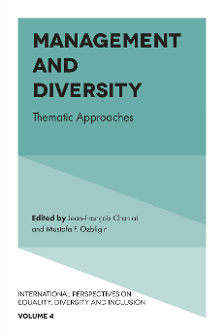DAFCO vocational training organisation
, 22
Department of Immigration and Multicultural Affairs (DIMA)
, 272
dietary prohibitions and obligations, diversity of. see religious dietary obligations
differentiation, principle of
, 232
disability and entrepreneurship
, 222–224
Disability Discrimination and Human Rights (Sexual Conduct)
, 267
discrimination
, 110
cost of
, 44–45
due to physical appearance
, 135–137
consequences
, 141–142
employment
, 112
prevention of
, 43–44
religious traditions as perpetrators
, 112
sexual orientation
, 111, 113, 120
towards sexual minority
, 116–122
workplace
, 39, 134–138
discrimination-and-fairness model
, 26–27
diversity, conceptualization of
, 13–14, 336–337
approaches
, 349–352
consequences of
, 342–346
diversity achievements
, 346
diversity-firm performance relationship
, 346
diversity recruitment research
, 347–348
diversity training
, 348
effects on workforce compositional outcomes
, 348
global perspective
, 350–351
mechanisms and effects
, 337–342
psychology of
, 344–345
within teams
, 364–366
in terms of socioeconomic trends and social forces
, 350
diversity agreements, analyses of
, 232
acquisition of the diversity label
, 240–241
approach by public-targets
, 238–240
cautious involvement of social partner in
, 241–243
Labour code, equality between men and women
, 238–240
negotiation and signature of collective agreements
, 240–241
research methodology
, 237–238
steps of negotiation
background and channels of communication
, 250
conclusion of agreement
, 248–249
factors of success of
, 244
implementation of agreement
, 249–250
monitoring and evaluation of a collective agreement
, 250–251
negotiation and formalisation of an agreement
, 247–248
planning of negotiation
, 244–245
production of a diagnostic
, 245–246
diversity management
, 2, 256–259, 347–349
as an individual competency
, 28–29
as an organisational competency
, 20–21
as an organisational phenomenon
, 322–323
anti-discrimination legislation
, 30–31
“anti-models” of
, 26–27
in Australia
, 259, 261–263, 273–274
benchmarks
, 48
Bourdieuan approach
, 285–286
in Coles supermarket chain
, 274
commercial advantages and
, 46–47
company leadership and
, 50–52
company’s commitment
, 43
competitive rationale
, 326–328
conducting a diversity process
, 44
contingent rationality of management by competences
, 29–30
criticisms of
, 32–33
divergence between multiculturalism and responses
, 267–275
diversity marketing strategy
, 46–47
as economic performance lever
, 42–47
efficacy (business case) associated to
, 232–233
good
, 28
legal regulatory framework for anti-discrimination
, 270–271
linear and oppositional perspective
, 260–261
link between diversity and performance
, 26
mainstream business
, 311
for optimisation and improvement of HRM and management
, 44–45
over-financialisation of
, 330
ownership for
, 304–309
as performance lever
, 47–52
policies of
, 232
labour unions and
, 233–234
potential effects on performance
, 43
prevention of discrimination and targeted positive action
, 43–44
principles of productive diversity
, 272
promise of
, 366–368
relationship between multiculturalism and anti-discrimination laws
, 263–266
relationship between team diversity and economic performance
, 47
in Rio Tinto
, 273–274
role and agency of diversity managers
, 284–285
scholarship
, 285
senior management support
, 287, 298–299, 303–306, 309, 312
as a stimulant to creativity and a key factor for innovation
, 45–46
diversity managers
, 11–12
association between trade union ownership and
, 307–308
balanced scorecards of
, 312–313
credibility and positional authority
, 301
effectiveness in job
, 292
expertise and skills of
, 287–297
of financial sector organisation
, 300, 305, 310, 312–313
of a global petrochemical company
, 296
job status and organisational position of
, 297–303
of large retail company
, 295, 305
of local government organisation
, 293, 309–311
marginalisation of
, 303
in national government organisation
, 293
organisational power and effectiveness of
, 306
organisational support for
, 303–313
professional identity of
, 286
of public sector organisations
, 298
salaries of
, 299–300
diversity policies
, 3, 38
complementary aspect of
, 40
defining
, 39–40
effects on management practice
, 42
factors determining success of
, 41–42
implementing
, 40–42
involving aspects of HRM
, 39
outcomes of
, 40–42
renewing of management and
, 41
social change and
, 40
dynamic collective learning process
, 3
